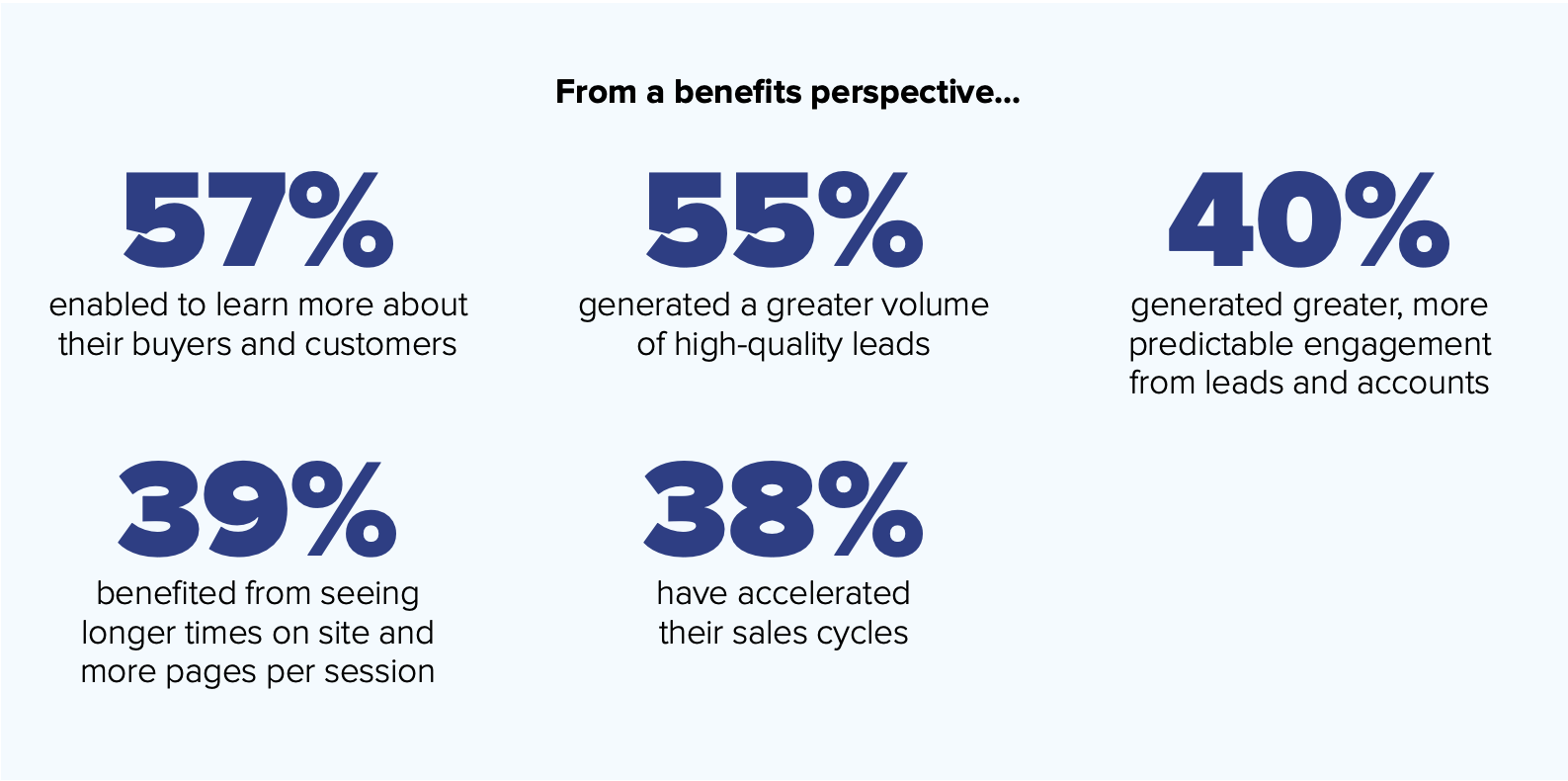Chatbots have been pronounced one of the biggest web development trends of 2022. Even though they’ve been around for several years now, their potential is still unfolding. These days, to stay afloat, businesses cannot but continuously evolve by adopting new trends. Luckily, there are a number of compelling examples of how chatbots can benefit different types of companies. Thus, it’s no surprise why these conversational agents prove to be the technology more and more companies are ready to implement.
In this article, we will provide a complete guide to chatbot development. We will discuss in detail what a chatbot is, what types of chatbots are there available, and why a business should consider implementing this technology. We will also break down a chatbot development process into successive steps and how exactly one should take them to succeed.
What is a chatbot?
Chatbots are artificial intelligence human-computer dialog systems that are based on natural language processing and, therefore, can behave in a human-like manner. Nowadays, these interactive software platforms can reside in apps, live chat, email, and SMS. The first conceptualization of chatbots goes back to the 1950s, but their adoption dramatically accelerated following the chatbot platforms’ launch by Facebook, Skype, WeChat, and other prominent industry players.
As of today, there are several specific features that make a chatbot a useful and powerful tool in one’s business toolbox:
- Natural language understanding and responses
- User-friendly task-oriented functionality
- Emotional intelligence
- BI and analytics
- Deep learning
- Unlimited scalability
- Multiple languages support
- Subscription messaging
- CRM integration
That said, what every chatbot needs to effectively mimic the human-human interaction, first and foremost, is natural language processing (NLP.)
NLP is a technology that enables chatbots to become more humane than they used to when their task was to replicate common customer service scripts. In order to understand the user input, the chatbot has to convert the unstructured conversational human language to structured data that computers will be able to interpret. This interpretation is made possible through the process known as natural language understanding (NLU.) The user sends a message to the bot, and then it is processed by the algorithms trained to extract the meaning. This is a more detailed and coincide view on how chatbot with NLP works:
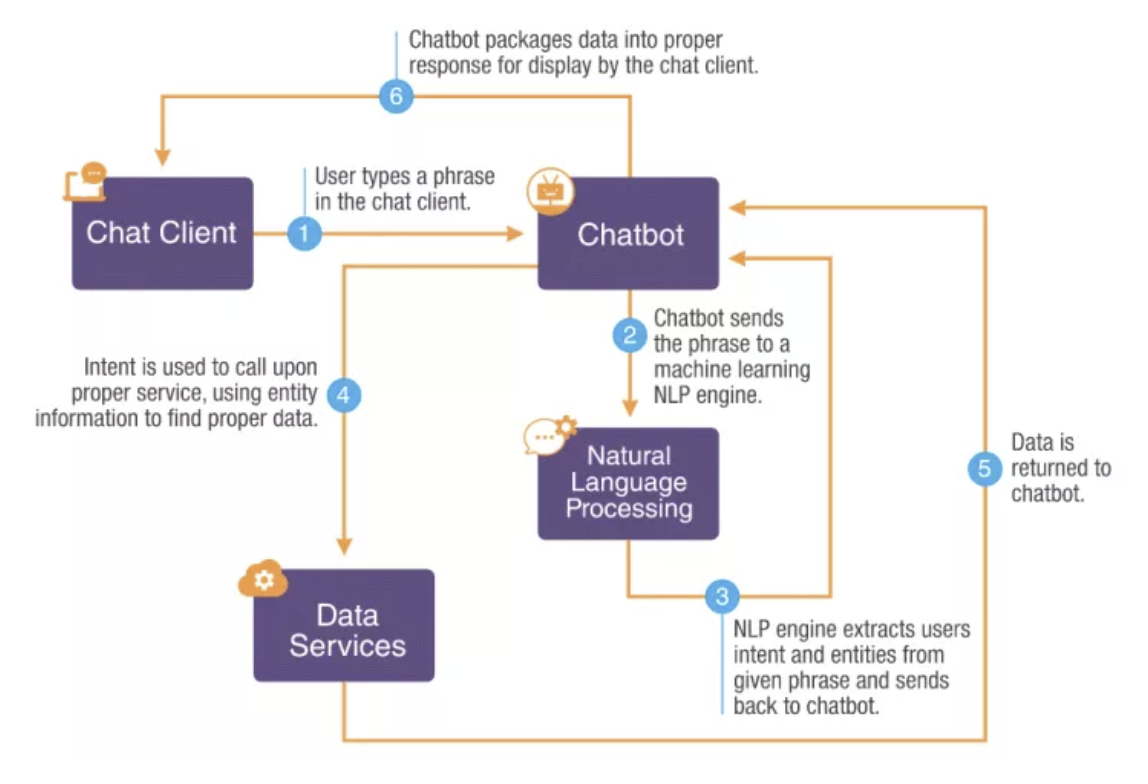
A chatbot with NLP is capable of recognizing the context and meaning of user text-based input and, eventually, the users’ intents. By building an NLP model, you expand the range of your chatbot’s possibilities. The user demands are getting only higher, so a chatbot that cannot provide the value of Natural Language Processing can have no value at all for some groups of people.
NLP-powered chatbots are a prime example of automation technology. And even though chatbots are relatively complex to develop, there are more and more business leaders and decision-makers turning to this technology in an aspiration to improve their sales, marketing, and customer service. Furthermore, the chatbot market in 2018 was valued at $1.17 billion and is forecast to reach up to $10.08 billion by 2026, which means the compound annual growth rate is expected to be 30.9%. Fascinating, isn’t it? And there are definitely some convincing reasons why the demand keeps rising and why companies, in response to this demand, are readily developing advanced chatbots.
Types of chatbots
For simplification purposes, most classifications single out two main chatbot types: pattern-based chatbots and learning-based AI chatbots. The former is more primitive, while the latter is more advanced and sophisticated.
Early chatbots were the chatbots using pattern matching for text classification and response reproduction. ELIZA was the first chatbot of this kind released as early as 1966. Basically, such chatbots are designed to follow conversation decision trees, which makes their responses predictable, repetitive, and deprived of the human touch. Usually, a bot asks a user a question, and the answer is either selected from the available options, or it has to contain a specific keyword explicitly matching what the bot has been trained on so that the conversation could move forward. Such chatbots are accurate only when the user input is exactly what the bot has been trained to answer. Pattern-based chatbots also do not store past responses, so the conversation can quickly reach a deadlock.
AI-based chatbots are much more successful as they use the power of ML not only to match the output with the user input but also to understand, contextualize, and predict. This is the type of chatbots that is nowadays used to effectively optimize the work of sales representatives, customer support, that is used in personal assistance, and more. The algorithms in AI-based chatbots are trained using historical data from actual user responses. Due to their ability to understand the context of a message, they can more naturally engage in a conversation without being explicitly trained and, thus, can be further improved through ongoing user feedback.
However, all chatbots can be further classified into smaller groups using different parameters:
Open-domain and closed-domain chatbots - those that can respond appropriately, discussing general topics or are focused on a particular knowledge domain.
Chat-based and task-based chatbots - those that talk to a user or help them perform a task.
Chatbots developed using open-source and closed platforms - those that are created using open-source or proprietary code.
Interpersonal, intrapersonal, and inter-agent chatbots - the chatbots that get and pass information without close sentimental proximity to the user; the users’ companions that understand them as another person would do; and the chatbots that can communicate seamlessly with one another.
Chatbots developed using rule-based, retrieval-based, and generative models - the chatbot we earlier called pattern-based, it chooses the response based on a fixed predefined set of rules; the chatbot that uses APIs to retrieve answers from other resources; and the chatbot that uses ML and deep learning to dynamically produce responses based on the previous user inputs.
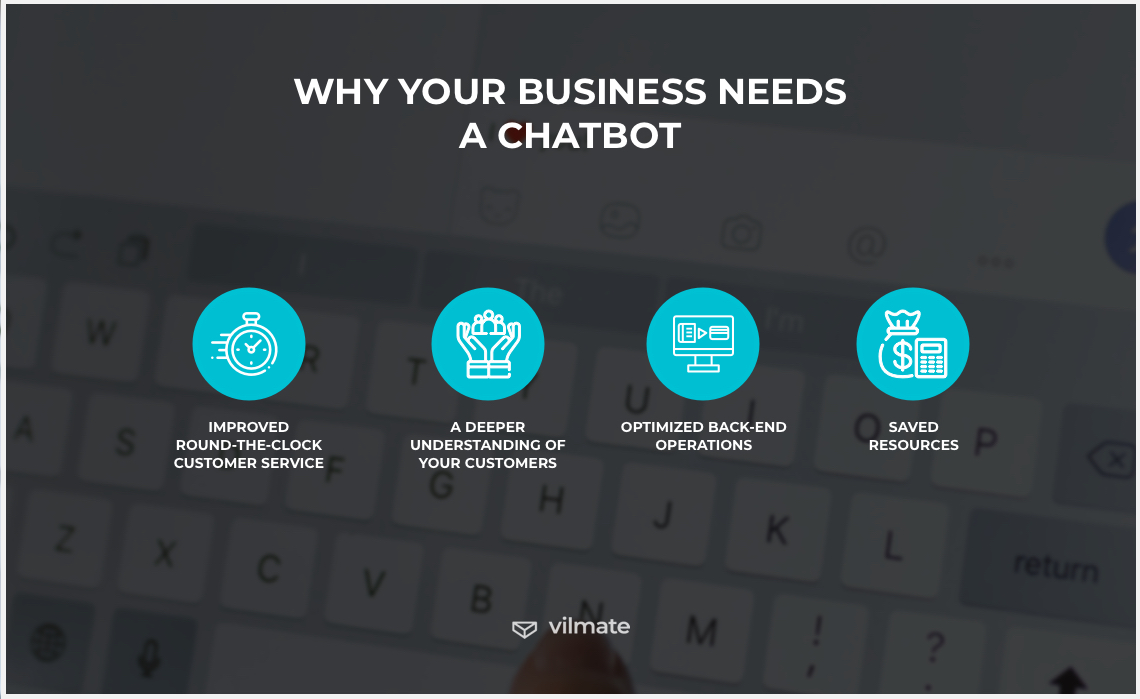
Why your business needs a chatbot
Businesses are beginning to see the benefits of using chatbots for their consumer-facing products. According to a survey by Oracle, when asked which emerging technologies they think will improve their customer service most, 80% of brands surveyed stated they had already implemented or planned to start using chatbots by 2020. It is principally because these businesses have concluded that the benefits of chatbots are all worth investing in their development. Accordingly, whether you need your own chatbot or not will depend entirely on your willingness and readiness to invest in and work towards the following positive outcomes:
Improved round-the-clock customer service
You can use a chatbot to make your brand interactive and accessible 24/7. With chatbots, your customers will be much more likely to get instant and consistent answers to the questions they would have. This responsiveness allows for generally better customer experience, improved customer satisfaction, and increased customer engagement. Direct messaging is one of the best ways to access reliable information, and chatbots can dramatically reduce or even eliminate wait time for the next available operator, allowing customers to get swift and reliable answers even during after-hours.
These chatbot-provided responses will most likely be recorded and personalized. Recordability, in turn, can benefit both a business and a customer. Upon the customer’s consent, the business will get some important insights, while the customer will be able to take screenshots of a conversation to act upon them later on.
A deeper understanding of your customers
Chatbots have benefits to offer to both companies and customers beyond cost savings. Thus, for example, businesses that have implemented chatbots can get a better understanding of customers’ needs and wants. However, this will only be possible if a chatbot is advanced enough to understand and serve customer queries flawlessly.
In particular, the recordability we’ve mentioned in the previous point is instrumental in obtaining actionable insights. Chatbots can grab the needed information not only to respond instantly and accurately but also provide your business with detailed records of customers’ pain points. This information can be used to address them one by one in the future. A chatbot is a perfect tool for learning about customer expectations. It takes some time to train it to obtain the necessary data. Still, once this stage is completed, you will be able to receive feedback through customer-chatbot interactions and plan your organizational improvements accordingly.
Optimized back-end operations
Not only can a chatbot replace efficient human support when it cannot possibly be provided, but also conversational AI can further increase customer support capacity. It is achieved through the automation of high-volume customer interactions, enabling a more consistent information flow and augmentation of human support staff.
It has been repeatedly proven that customer service performance gets better when augmented by AI. Continuously active chatbot platforms can help companies get improved operational outcomes, such as shorter wait times that we’ve already mentioned, establishment of better ways for app or website users to find information they are looking for, or automation of new leads acquisition. Specifically, chatbots can help mine customer data and drive new leads by harvesting prospects’ email addresses or prompting them to give feedback.
Saved resources
Potential multiple savings resulting from chatbot implementation is one powerful argument that companies should bear in mind.
Conversational marketing solutions are reported to improve a customer journey saving time and money.

Source: Drift Even though complete automation of the customer service and sales workforce is not attainable, you’ll achieve considerable savings even partially automating these positions. By putting chatbots in charge of customer conversations, you can save on your employees’ labor costs and then allocate these resources more efficiently. Thus, according to Public Tableau, 36% of sales representatives’ and 29% of customer service representatives’ work time and effort in the US are automatable, which means this work can be automated through chatbots and other tech innovations.
That said, we cannot deny that the implementation of a chatbot requires initial investments. Still, except for that, chatbot maintenance extra costs will be relatively low. And given that chatbots will also drive savings on customer service department labor costs, the technology adoption promises the conversational-AI-powered businesses a dramatic decrease in their day-to-day expenses in the long run.
How to develop a chatbot from scratch
If you feel convinced that custom chatbot development is the right thing to do, let’s now find out how to invest management time and engineering effort best in order to build a chatbot solution perfect for you and your business.
The question that frequently arises when an organization arrives at the idea of chatbot development is what exactly they should do and in what sequence to turn this idea into an actual feature. For your convenience, we’ve prepared a step-by-step guide on how to create a chatbot. Let’s look at each of the seven stages – from choosing the chatbot type to chatbot deployment and maintenance.
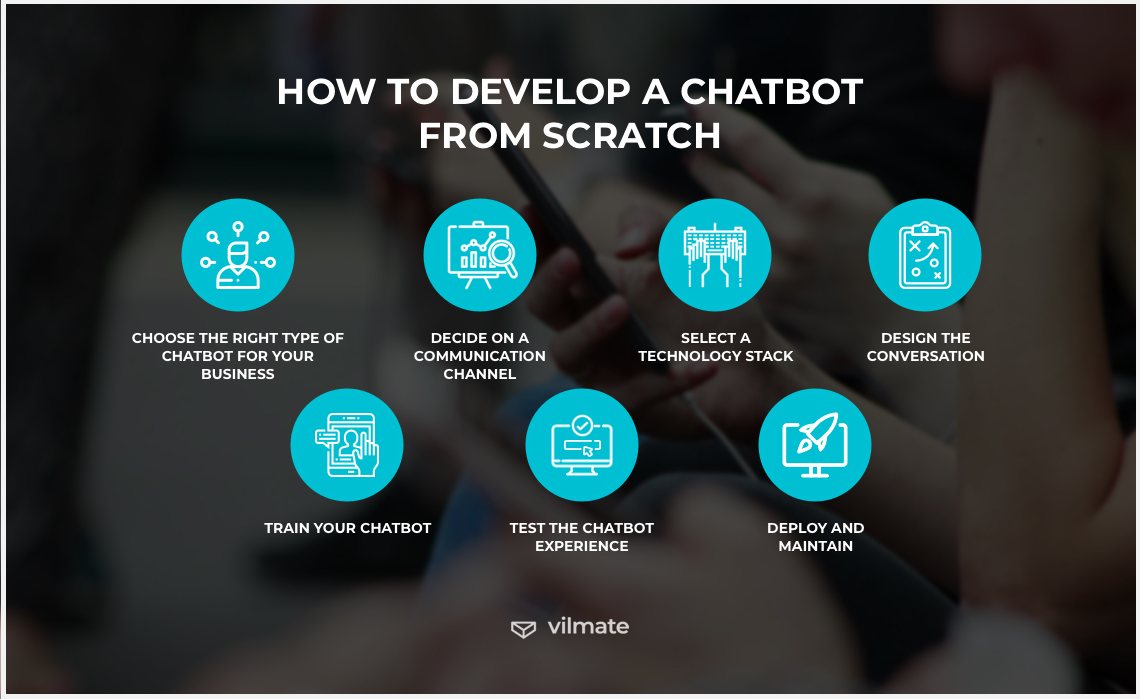
1. Choose the right type of chatbot for your business
Earlier in the article, we’ve discussed what chatbot types are there and briefly described the differences between them. So, identifying which one is right for you must be the first step in your chatbot development process.
Basically, here, your future bot conceptualization begins. As different chatbots will take different approaches to understanding a user query, it’s essential for your company to define from the outset what you want to achieve with the chatbot. Today’s most popular chatbot use cases are customer support and sales, so make the objective definition your starting point. Then try to define what specific positive outcomes the user is expected to obtain through the use of a chatbot, what your chatbot strategy is going to be, and what the bot will have to do to help the user achieve the desired outcome. Will it be a FAQ bot fetching answers to users’ questions or the one gathering data, providing consultations, and even entirely substituting human customer support or sales representative?
Your company should define what type of chatbot you will start developing based on your business goals and customers’ demands. When it is clear what your chatbot would do, it will also become less troublesome to go through the rest of the stages.
2. Decide on a communication channel
Once the conceptualization phase is completed, you should proceed to choose a suitable communication channel. The medium that the chatbot uses is another important factor to consider.
Chatbot reflects the brand identity. Therefore, you should select the channel that will seamlessly complement your brand experience. Besides, the use of different media will emphasize different aspects of the service. So, keeping in mind all the insights you’ve acquired when taking the previous step, you should further clarify the following points:
- Voice-based or text-based communication
- The way your chatbot is discovered and promoted
- The type of connection between the customer and the bot
- The target audience of your content
- Whether or not a conversation with a bot is switchable to a human
This information must give you a better idea of how people are going to interact with your chat bot. In order to create an experience that converts, you must know what user wants you should meet and what sentiment you wish to capitalize on during the interaction. You need to find the best way for people to discover your chatbot and reach out to you. Then select the most suitable deployment channel – a web widget on your website, messaging apps like Facebook Messenger or Telegram, cloud networks, SMS, or email.
Chatbots are flexible enough to integrate with a variety of platforms but creating your own chat bot hosted on your site or as a standalone mobile app has its perks.
Besides, opting for a multi-channel strategy, you can bring even more benefits of a chatbot to the table. The only thing is that you should preferably use more or less the same technology stack across the platforms.
3. Select a technology stack
It is no easy task to select technologies for automating human conversations. However, it’s been a while since chatbots took off, so the development stack has, just like AI and ML technologies themselves, has evolved to become more established.
To begin with, any chatbot service is powered by rules and workflows automated using a chatbot interface. Accordingly, the chatbot ecosystem has been quickly expanding over the last couple of years to now enable interaction with a human using specialized tried and tested chatbot development tools and chatbot development platforms.
This ecosystem of the underlying technology and platforms consists of deployment channels, third-party chatbots, technology enabling chatbot development (APIs, NLP platforms, etc.,) and native bots.
For instance, the basic technologies and components of the chatbot ecosystem were classified by O’Reilly as following:
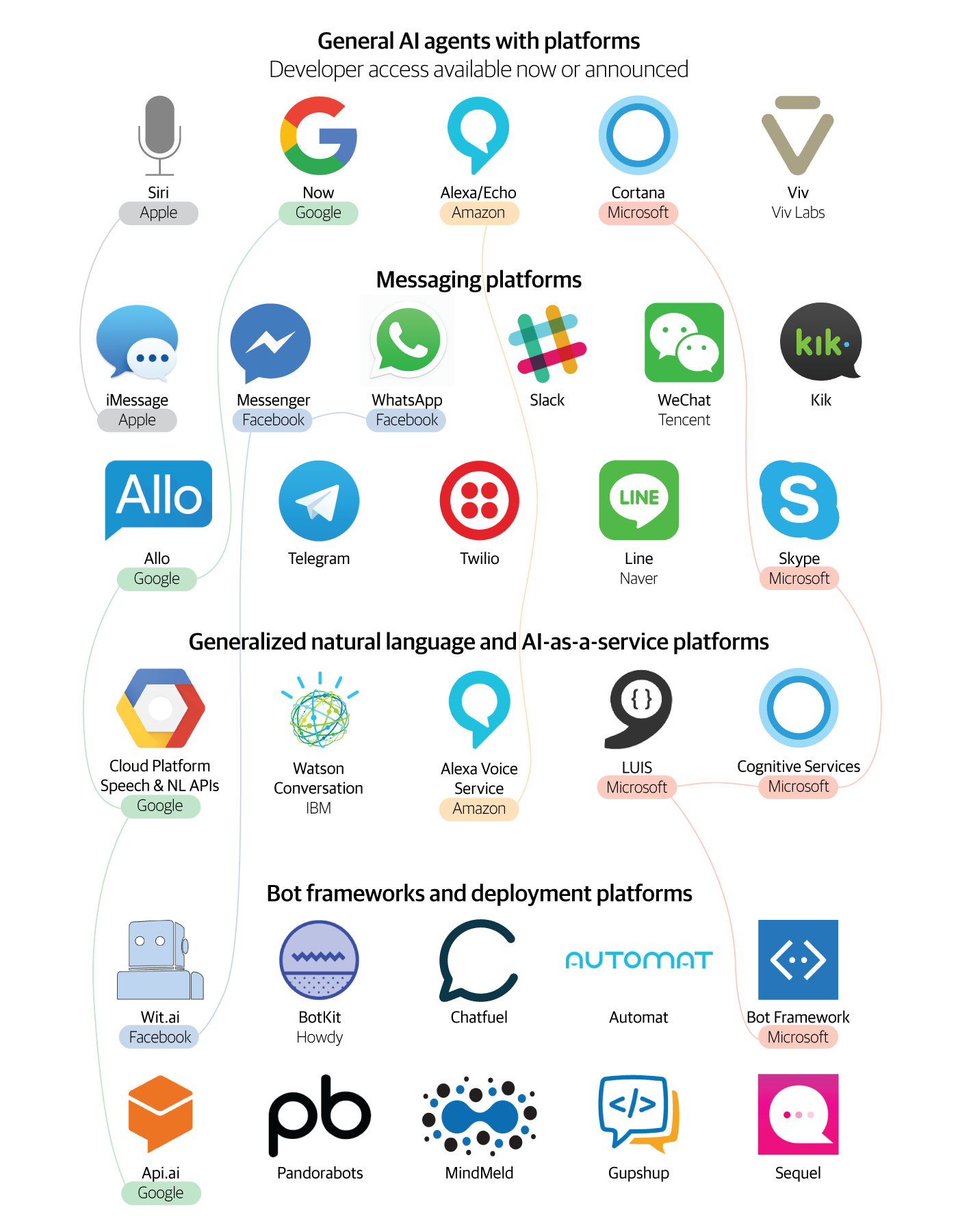
4. Design the conversation
All the work that has been done up to this point will be meaningless if you fail to create a smooth chatbot conversation flow. As a rule, the main objective of chatbot development is customer service optimization. In view of this, you must take care that the progression of questions and responses in a chatbot-human conversation is effortless.
Creating your chatbot persona may become the first step towards designing a quality conversation. Giving your bot a name and a tone of voice when writing a script that flows is an important part of the design process. If you’ve done all the preparations well and defined how customers will interact with the сhatbot, then it will be easier to align interactions with the brand identity you’ve come up with.
Only the bot that speaks and performs well can ease the workload of your customer support agents and improve brand perception. These tips should help you make it really so:
Begin with the most necessary parts of your chatbot conversation
First, write the main flow for the end-to-end ideal experience
Add as many appropriate offshoot flows to the flow map as possible
Give your bot a persona and a tone of voice
Create a complete conversation diagram: greeting, asking, informing, clarifying, apologizing, suggesting, failing to understand, and concluding the conversation
Keep your bot’s purpose in mind when writing conversation scenarios
Train your chat bot and test its conversation flow
5. Train your chatbot
Needless to say, it’s challenging to predict all the queries coming to the chatbot. Therefore, once the conversation scenarios are ready, it’s time to train the chatbot. It will be more rewarding to stop guessing what the customers are going to write or say and instead start using the data you have to train your bot.
For some businesses, a chatbot that relies on a script and an API link to a website will suffice. However, if you wish your chatbot to perform a wide range of tasks in a human-like manner, it must be trained. So, how exactly are chatbots trained, and how much training is enough?
In the first place, chatbots can be trained through the data your business has already collected from call center digitized transcripts, emails, messages on Facebook Messenger, and other similar sources. More mainstream sources of data for chatbot training include Microsoft Research Social Media Conversation Corpus, Ubuntu Dialogue Corpus, Chinese Treebank, and Microsoft Azure LUIS.
As a result, this chatbot trained on the right type of quality data will be able to understand what it is being asked through NLP and respond appropriately.
6. Test the chatbot experience
To put your conversation flow to test and check if your chatbot does what its designers intended, you can do it either with a prototype or a production-ready chatbot. Regardless of which option you choose, there are equally lots of ways to test your bot before it is deployed and released.
First of all, the chatbot can be tested manually. For example, you can launch it in Messenger and start testing the bot’s behavior throughout the conversation flow by sending different queries intended to make the chatbot respond in a specific way. It is also important to check such aspects of the workflow as intent matching, fallbacks, navigational scenarios, tone of voice, entity recognition, and user’s request fulfillment. The next steps are usability testing and user feedback acquisition. Once you are satisfied with the experience, it’s a good idea to start testing the chatbot with a small group of customers and keep scaling up until the product is available to everyone.
7. Deploy and maintain
After you have successfully completed all the previous steps, you are all set to deploy and release your chatbot. Although you should be certain that the chatbot experience will be satisfying and enjoyable for customers, in fact, the ongoing journey of maximizing quality only begins. Once you’ve found your chatbot’s voice, the opportunities for improvement are infinite.
To help the business reach its goals, the chatbot must keep advancing. There are many useful best practices to help you perfect the quality of your chat bot. Among others, they include best practices for change management (which is inevitable when designing a chatbot,) source code management, and automation (automated testing, deployments, and more.)
Conclusion
Chatbots are becoming instrumental in helping businesses reach out to broader audiences and more efficiently serve their needs. They are at the heart of AI technology symbiosis with the business world, minimizing human interference in brand experiences.
At the same time, chatbots have the potential to develop into a capable information-gathering tool. Their implementation into your organization’s processes promises significant savings in customer service and sales operations. And the quality of chatbot interactions is only going to increase with AI and ML advancement.
Suppose you’d like to get to know your audience better, connect with them, help them address the encountered challenges, do it all at any time of the day or night, cost-efficiently for your business and satisfyingly for your customers. In that case, chatbot development is right for you! At Vilmate, we offer comprehensive software development services. We always aim to provide the best solutions to our clients across a variety of industries and domains. Contact us today, and we’ll be happy to discuss your chatbot development idea!
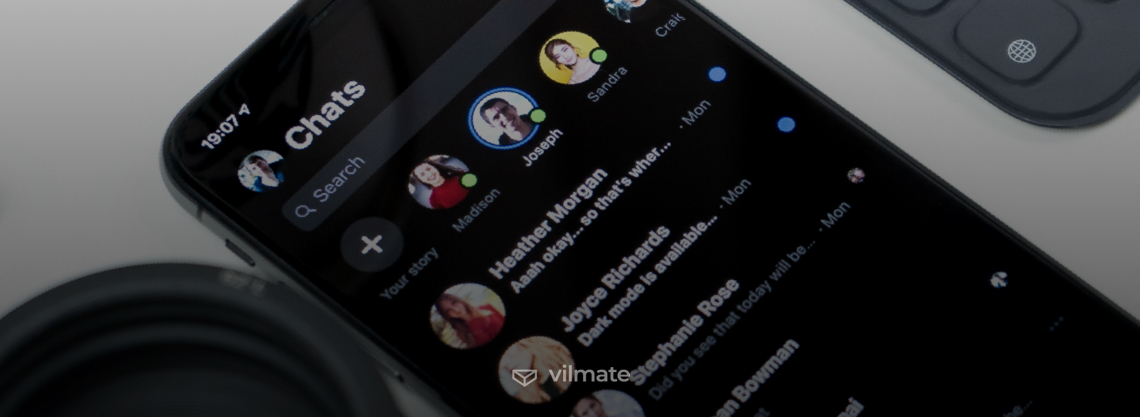
© 2021, Vilmate LLC
Updated: Oct 3, 2022
